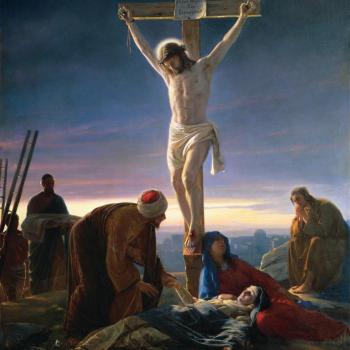 I started praying the rosary at a young age, probably before I started Catholic school in kindergarten. Of course, all through Catholic elementary school we prayed a decade of the rosary as a school each morning during the months of May and October, traditionally considered “Marian” months. Sometime in grade school, probably first grade, I received a really nice Italian rosary from my uncle who is a priest. It was blessed by Pope John Paul II, and I remember being very proud of it. I was crushed when it was stolen from my desk one day.
I started praying the rosary at a young age, probably before I started Catholic school in kindergarten. Of course, all through Catholic elementary school we prayed a decade of the rosary as a school each morning during the months of May and October, traditionally considered “Marian” months. Sometime in grade school, probably first grade, I received a really nice Italian rosary from my uncle who is a priest. It was blessed by Pope John Paul II, and I remember being very proud of it. I was crushed when it was stolen from my desk one day.
In junior high and high school my love of the rosary deepened as I began to make my faith my own in new ways. I participated in rosaries against abortion and for vocations. From my senior year of high school through my freshman year of college I was in a long distance relationship, and my girlfriend and I would arrange “rosary dates” once a week. Where ever we were, we stopped what we were doing and prayed a rosary together.
During my sophomore year of college I switched my major from communications to theology. As most Catholics who study theology will tell you, there is a certain crisis of faith that occurs somewhere along the line, a crisis of faith that comes from exposing one’s beliefs to new kinds of scrutiny and where it feels as though the floor has dropped out beneath you. The de/reconstruction process that often occurs in the course of theological study is somewhat terrifying at times, but can also be a profoundly liberating process, as it gives more opportunities to rediscover and reappropriate the faith of the Church as one’s own. It doesn’t take entrance into a theology program to experience this. All it takes is a serious commitment to enter into the reflectiveness of faith seeking understanding, a reflectiveness that all Christians are called to: all Christians should be, and are, theologians.
Somewhere in this process I purged my spiritual life of many of the forms of prayer from my past, including the rosary, because I began to see the dangers of various popular devotional practices. I dropped the rosary. Eventually I dropped eucharistic adoration. My theology professors certainly did not encourage this. While we discussed the dangers and distortions of various religious practices, all of them, even the most “liberal,” discouraged a type of theological elitism that looks down on popular devotions. Still, because of the shifts in my theological and spiritual horizons that I was experiencing, I felt that I had to reject the rosary as “not fitting” with “where I was” on my “spiritual journey.” I began to explore a whole new world of prayer styles: the Examen and imaginative scripture reflection of Ignatian spirituality, centering prayer, apophatic “emptying” meditation, the Liturgy of the Hours, labyrinths, you name it. At various points in my college career, masters’ work and service as a lay minister in campus ministries and parishes, I have been drawn to different prayer styles for various reasons. But the rosary was, for some reason, left out the entire time.
That is, except in times of extreme need. A Jesuit spiritual director of mine — a close friend of Pope Benedict — gave me one of those single decade rosaries during a “busy student” retreat in college. For some reason I kept the rosary in my car. I always seemed to need that rosary in dark times, times when I felt depressed or confused. Sometimes these cases were in the context of troubled romantic relationships; I just somehow felt that my Mother would understand. On at least one occasion, clutching that rosary probably saved my life. But while I found comfort — and quite literally, salvation — in that rosary, I never saw a need to come back to it, except in these extreme, dark cases. Still, I wondered why I was drawn to the rosary in these times, what it meant.
Fast forward to the present. For some reason I have been drawn to the rosary lately. Not because I am depressed — nearly eleven months after the birth of my daughter, I’m the most deeply happy that I’ve ever been. In fact, I have no idea why I feel drawn to it. Some of it might have to do with another theological turn that I am making — toward a recognition of the importance of popular religious practices as a source for theology, as Latino/a theologians and others are making increasingly clear. My interest in the theologies of marginalized peoples, for example, has impressed upon me that Our Lady of the Poor is also Our Lady of the Rosary.
But there is more to it than simply making intellectual connections and then a subsequent move to be in solidarity with the spirituality of the poor and marginalized. For me, like so many other Catholics I think, prayer has been a struggle. It’s been a struggle because I tend to view prayer in terms of technique rather than an opportunity to “waste time” in consciousness of God’s transforming presence. Perhaps I am being drawn back to the rosary because, in the eyes of the world, it is so obviously a “time waster,” so very unlike the spiritual wares being sold to a consumer culture that is suddenly rediscovering religion — er, spirituality — as a path to “personal wholeness.” The rosary is countercultural. Unlike other forms of spiritual practice, even some Christian forms, which almost seamlessly affirm american individualism, consumerism, and self-obsession, the rosary seems to me entirely out of step with mainstream american culture. Praying the rosary is not easily combined with liberal ideas of individual self-betterment. It is not easy to “get something out of” praying in this way. Note, for example, how most times Catholics pray the rosary not for themselves, but for others: “I’ll pray a rosary for you and for your intentions,” “Come pray a rosary for peace,” “This rosary is for a deeper respect for life at all its stages.”
Still, for all its countercultural aspects, it is still difficult to integrate the rosary as it has been traditionally practiced into my self-understanding of what it means to follow Christ, to be a Christian. In response to having grown up in a part of the united states that is particularly drenched (drowning?) in individualistic and spiritualized conceptions of Christianity, my spiritual and theological path has taken me to a deeper understanding of the social and political dimensions of Christian faith, not as an avoidance of the personal dimension but as the only way the personal dimension can be authentically Christian.
So imagine my excitement when I found a recent piece by a Capuchin by the name of Brother Vito who reflects on similar issues regarding his recitation of the rosary. Br. Vito is involved in social ministries and activism, and he expressed frustration with finding time to pray and with integrating the traditional form of the rosary into his activist spirituality.
His solution was to rethink the mysteries of the rosary in a way analogous to John Paul II’s introduction of a new set of christologically-focused mysteries to the rosary a few years back. As the Pope wrote,
I believe, however, that to bring out fully the Christological depth of the Rosary it would be suitable to make an addition to the traditional pattern which, while left to the freedom of individuals and communities, could broaden it to include the mysteries of Christ’s public ministry between his Baptism and his Passion.
In a similar way, and noting the Pope’s emphasis on the “freedom of individuals and communities” and respect for their needs, Br. Vito has developed a set of mysteries called the “Subversive Mysteries,” five events in the life of Christ that he finds particularly fruitful for reflection from the perspective of a Catholic engaged in social justice work. Each mystery includes a “fruit” for which one could pray for that mystery, as well as a prayerful reflection question.
1. The Magnificat
Fruit: Service/Model of LiberationChallenge: Am I a humble servant, or do I try to make myself important?
2. The Gathering of the Disciples
Fruit: (Grass Roots Organization)Challenge: Can I work with people of different beliefs, gender, or culture towards the reign of God?
3. The Cleansing of the Temple
Fruit: (Protest of Exploitation)Challenge: Does my work reflect the Gospel, or are my acts full of empty anger and destruction?
4. Jesus Is Tried As A Criminal
Fruit: (Passive Resistance, Defiant Truth)Challenge: Will I speak the truth when confronted with fear, personal injury, or the lure of money/power?
5. Jesus Appears to Mary Magdalene
Fruit: (Empowerment)Challenge: Do I share my gifts with others so they may have a voice?
Br. Vito fleshes out the mysteries a bit in a follow-up piece here. As the rosary was originally a popular form of devotion, irrupting “from below,” it is altogether fitting that communities develop and implement new ways of praying the rosary, breathing new life into the older forms. It certainly seems to be in keeping with John Paul II’s intentions in his own development of “new” mysteries of the rosary.
The rosary, both in its traditional and “renewed” forms, reveals the mysteries of Christ’s relationship with his mother, a mystery that includes Mary’s Christlike, kenotic love: a love that has embraced me when I have been at my lowest and a love that embraces the poor and oppressed in their suffering. Mary opts for the poor still today and, like her son, announces the good news of liberation. How fitting it is to rediscover the rosary in these troubled times, and in doing so, to rediscover Christ and his mother’s option for the poor.

















